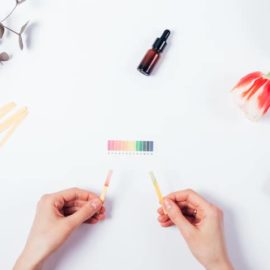REX HU INTERVIEW

Rex Hu is a former senior R&D engineer at Unilever who is now dedicates his time to sharing his technical knowledge on skincare innovation and formulation. Committed to establishing a good connection between people and information, he has become one of the most famous beauty bloggers and influencers in China, with 190,000 followers on Zhi Hu, 190,000 followers on Weibo and 40,000 followers on his own WeChat account. Rex is also a Headlines’ author (data mining) and a guest author on platforms such as Yan An Tang (scientific beauty research), Ding Xiang Yi Sheng (medical health) and NetEase aesthetics (beauty discoveries).
China is the world’s largest skincare market, so it has become vital to consider Chinese consumer demands when developing any skincare product. From your perspective, what would you say are the main beauty concerns for the Chinese consumer? How do they differ most from the rest of the world?
At present, Chinese consumers are more concerned about the effectiveness and safety of products.
In terms of effectiveness, consumers are more inclined to buy products with clinical data and demonstrated evidence rather than fancy advertising words. Consumers have heard of many technologies and new trends. Therefore, it is necessary to develop products in response to these new trends. For example, many Nobel Prize technologies are in some way applied to cosmetic products.
In addition, safety is also critical.
The first thing about safety is to be sure that there are no ingredients that are dangerous to the skin, such as some preservatives, emulsifiers, perfumes etc. Now that domestic laws and regulations are becoming ever stricter, it is easy for consumers to find out from various channels if an ingredient poses a problem. For example, paraben preservatives are not prohibited by laws and regulations, but consumers are consciously refusing to buy them.
As for green and sustainable development, I think it is important to do a good job in this respect based on the above two points. First of all, products must be effective and safe, and have a good sensorial experience. After all, we will care about ourselves first and then the environment.
Now more than ever, consumers want brands to be upfront and open about their practices. They will search for any kind of accreditation that can help to inform their purchase decisions: raw material safety certification, product efficacy data, quality control, production and environment information. Therefore, the use of certifications as signposts has become essential to build trust amongst consumers. Which would you say are the certifications that are at the forefront of the consumer’s minds?
In this respect, there is no authoritative certification in China. Generally speaking, clinical data are highly important in regard to effectiveness, and test data from public hospitals are the most authoritative, followed by data from private institutions.
In terms of safety, different testing institutions have different positions in the industry. It is difficult for consumers to judge at present, but it will become more and more transparent in the future. In particular, after the implementation of the new regulations, the state will certify some institutions for testing, and the credibility of these institutions will therefore increase significantly.
Let’s talk about one of the greatest consumer concerns worldwide: The ‘natural’ claim. What does it mean for the Chinese consumer? What do they expect from a product that claims to be natural? When looking for a natural cosmetic product, how much do you think the consumer values the natural qualities of its ingredients? How would you forecast its evolution in the future?
For Europe and America, this is an area that consumers are very concerned about. However, in China, this aspect may still be in its infancy. Consumers are more concerned about the benefits of these products for themselves than they are about their environmental benefits. Therefore, the most important thing is to satisfy the consumers in terms of the effectiveness of the product and raw materials, and then to focus on the protection of nature and environment.
Natural claims will undoubtedly enhance the image of the brand, which is why many top brands claim to be sustainable. However, at present, they still focus on marketing their own brands. Consumers will have a certain interest in this, but this is not the main reason why consumers buy a particular brand.
For a small number of consumers, they will pay more attention to the natural factors, but natural to them means their own safety and then the environment. At present, there are some brands focusing on this, we hope that in the future more and more consumers will be attracted to these issues.
We mentioned transparency and trustworthy accreditation before, when talking about certification. But nowadays, there is also another effective way of approaching consumers and gaining their trust: social media. How do you think digitalisation has changed the consumer behaviour? How do you think the digital beauty world will evolve in the long-term?
The most significant feature of digitisation is that it increases the channels of information acquisition and dissemination. Consumers can easily see evaluations of a product or raw material on social media, and then judge whether they need to buy the product or not according to what they find.
In the future, cosmetics will adopt more social media communication methods, using various methods such as audio, video and animation to influence consumers, so that consumers can fully appreciate the concept of brands and products, which is different from the past.
In addition, consumers will be more likely to use products and brands to represent their personality on social media. As a result, many personalised brands have emerged. Popular mass brands will gradually lose support and cultural diversity will become more and more important. Just like fashion industry, different personalities need different clothes and cosmetics.
Cosmetics companies should start from the root cause to take the path of sustainable development. Green and healthy cosmetic products must use natural and organic raw materials and advanced international processing technologies. If the source material is not properly controlled, then even if the process is more advanced, the fact that the raw materials are inferior cannot be changed, and the quality of cosmetics produced is bound to cause concern. Consumers have traditionally believed that raw materials grown naturally on farmland and farms are green and healthy, but many chemical companies are extracting green raw materials from some incredible sources. From the perspective of cosmetic innovation and development, what expectations do you have for raw material suppliers investing in product development processes?
Green and sustainable factors are very important themes for the future; green raw materials mean that the environment and the entire ecological cycle will not be harmed. In order to use some endangered species, the relevant license accreditations must be obtained, and we must also to have certain protection measures in place. The fact that there is an unquenchable thirst for nature does not mean that the concept of ‘natural’ is yet equivalent to ‘sustainable’.
At the same time, the collection of raw materials such as crops also needs to follow the rules of free trade, to benefit local residents, without damaging their environment and living standards, especially in regard to child labour and gender equality, two factors that many large companies will pay particular attention to.
Have there been any changes in the skin care demands of Chinese consumers in recent years?
The trends of Chinese consumers in recent years have been affected by several different factors, one being the pursuit of product effectiveness, more sensitive to clinical trials and data, such as the percentage of added ingredients and so on. Another is the pursuit of product safety, due to more and more sensitive skin, whether the product has controversial ingredients or not has become increasingly important. Many people will conduct a lot of research using a variety of apps, and then judge the quality of the product. Although this is not 100% accurate, it shows that people are concerned about this area, and consumers are beginning to actively carry out their own research rather than passively accepting advertising.
During the entire innovation project, we investigate the various production processes in order to harness the effects of green chemistry, and avoid dangerous reactions or dangerous by-products. Comparatively speaking, in order to achieve sustainable development in the cosmetics industry, what kinds of R&D innovation adjustments should we be focusing on?
In order to achieve sustainable development, it is necessary to adjust raw materials, manufacturing processes and other aspects.
The sustainable development of raw materials is crucial, paying attention to the negative impact of raw materials on the environment and the risk to human health, and also paying attention to the safety and non-allergenicity of ingredients. But at the same time, consumers do not want to compromise on product effectiveness, these two aspects should be combined.
In terms of technology, attention must be paid to the use of electric energy and produced water, we must try to reduce wastewater in the production process, and use cold matching technology to reduce energy consumption.
No comments yet
There are no comments on this post yet.





Leave a comment